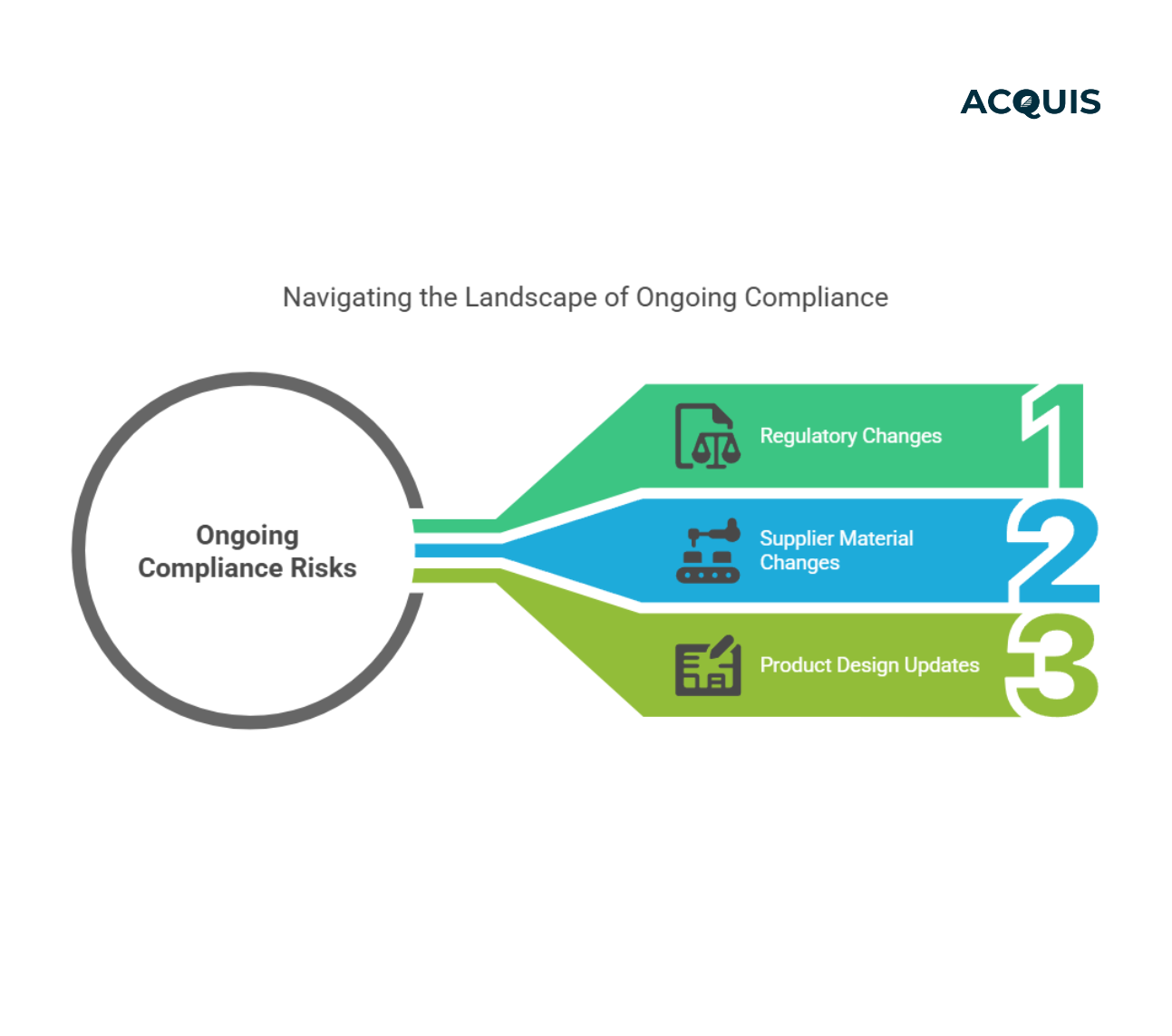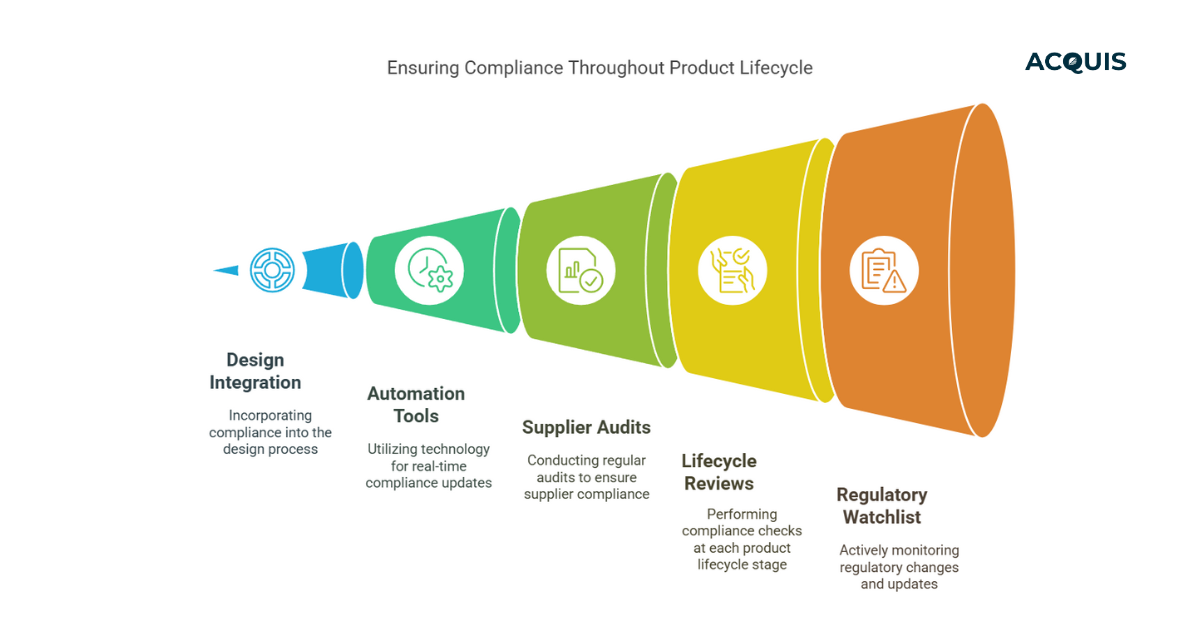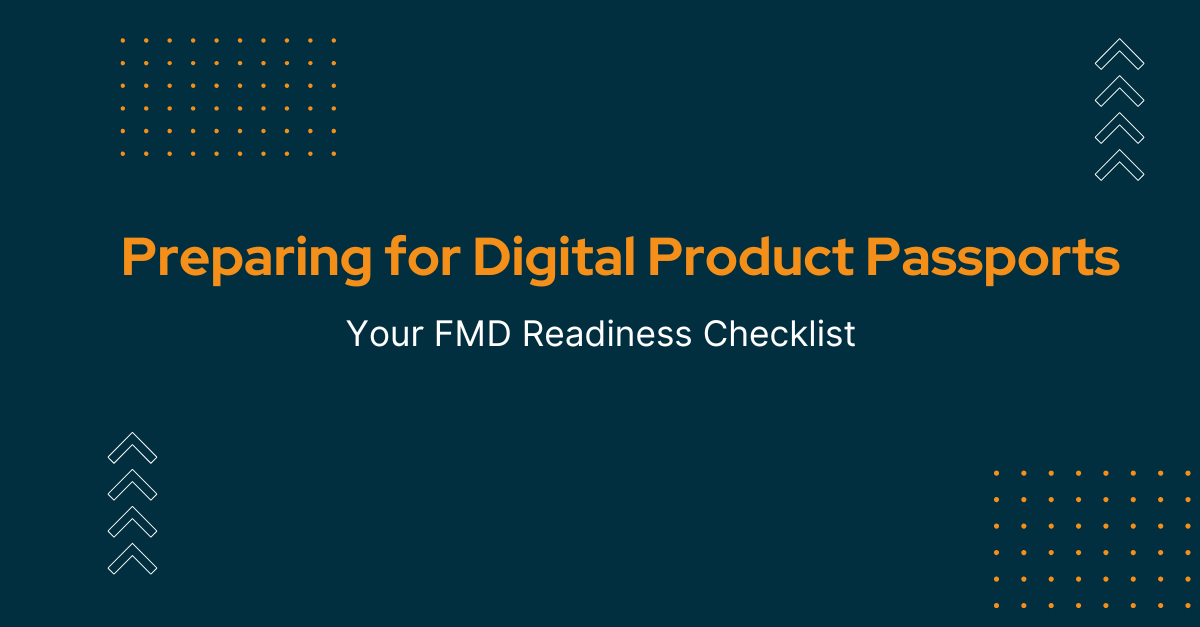Table of Contents
Regulations evolve. suppliers change materials. New restricted substances emerge. If you’re not actively maintaining compliance, you’re falling behind and inviting business risk.
Why Ongoing Compliance Matters
Imagine launching a new product, only to find out six months later that a material is now restricted under REACH. Now, you’re scrambling to:
- Find alternative materials.
- Update documentation.
- Inform customers about compliance changes.
Staying ahead of regulatory shifts is crucial—otherwise, you risk non-compliance, product recalls, and lost revenue.
The Three Key Compliance Risks Over Time
- Regulatory Changes: New laws & ammendments (e.g., TSCA, RoHS, PFAS bans) can make previously compliant materials obsolete.
- Supplier Material Changes: Your supplier may alter a formulation or substitute raw materials without informing you.
- Product Design Updates: Engineering changes can introduce new compliance risks that must be reassessed.

Without ongoing compliance monitoring, these issues can go unnoticed—until it’s too late.
How to Maintain Compliance at Every Stage
A successful compliance program doesn’t just collect data once—it monitors, updates, and verifies over time. Here’s how to stay ahead:
1. Build Compliance Into the Design Process
The best way to avoid future headaches? Start with compliance in mind.
- Use only pre-approved materials with full compliance documentation.
- Allow NPI (New Part Introduction) only after compliance validation.
- Work with engineering teams to ensure design for sustainability (e.g., avoiding high risk parts).
- Run pre-launch compliance checks before product release.
When compliance is baked into product development, last-minute surprises are minimized.
2. Automate Compliance Monitoring
Manually tracking every regulatory change? Impossible.
Instead, leverage automation tools to:
- Receive real-time alerts on new regulations & updates to existing regulations.
- Track supplier changes to materials and formulations.
- Ensure compliance data is continuously updated in your system.
Automated systems reduce human error and ensure nothing falls through the cracks.
3. Conduct Periodic Supplier Audits
Your supplier’s compliance today doesn’t guarantee compliance next year.
To prevent surprises:
- Require annual compliance updates from suppliers.
- Conduct random audits on high-risk materials.
- Establish a supplier requalification process for long-term compliance tracking.
Regular supplier engagement ensures you’re always working with current, verified data.
4. Implement Lifecycle-Based Compliance Reviews
Product compliance isn’t just about launch—it must be maintained throughout the entire lifecycle.
Key checkpoints include:
- Pre-production: Ensure all materials and components meet regulations.
- Post-launch: Conduct follow-ups as regulatory landscapes shift.
- Mid-life product updates: Review compliance whenever design changes occur.
- End-of-life considerations: Ensure proper disposal and hazardous material handling.
Each stage presents new compliance risks—proactive reviews help mitigate them before they become critical issues.
5. Maintain an Active Regulatory Watchlist
Waiting for compliance issues to find you? Bad idea.
Instead, actively monitor & subscribe to newsletters from regulatory bodies like:
- ECHA (European Chemicals Agency) for regulations such as RoHS, REACH, CMRTetc.
- U.S. EPA for TSCA PBT and PFAS regulations.
- Country specific regulatory bodies like China, India etc for region-specific compliance changes.
By keeping a live watchlist, you stay ahead of the game rather than reacting after problems arise.
6. Plan for Supplier and Material Substitutions
No supplier relationship lasts forever. Have a Plan B for key materials in case:
- A supplier discontinues a compliant component.
- A new restriction forces material substitution.
- A geopolitical event disrupts supply chains.
Alternative sourcing strategies ensure compliance continuity even when unexpected changes occur.
7. Train Internal Teams on Compliance Best Practices
Compliance isn’t just for legal teams—it’s a cross-functional effort.
Regular training for:
- Engineers: Designing for sustainability as a engineering practice.
- Procurement Teams: Understanding supplier compliance obligations & risk.
- Quality Control: Identifying potential compliance red flags in materials.
When compliance knowledge is shared, fewer issues slip through the cracks.

The Cost of Not Staying Compliant
Still think ongoing compliance isn’t worth the effort? Here’s what happens when companies ignore it:
- Fines & Penalties: Regulatory violations can cost millions.
- Product Recalls: Non-compliance can force a company-wide recall.
- Customer Contract Losses: OEMs and big buyers demand up-to-date compliance data.
- Reputational Damage: Compliance failures erode brand trust and market position.
The cost of not maintaining compliance far outweighs the investment in ongoing monitoring.
Final Thoughts: Compliance is a Moving Target
If compliance were a one-time project, it would be easy. But the reality is, it never stops changing.
- Regulations evolve.
- Suppliers update materials.
- Products go through modifications.
The key to staying compliant is treating compliance as a continuous process, not a one-off task.
Take control of your compliance lifecycle today—because when it comes to regulatory risks, proactive beats reactive every time.
Learn about Future-Proofing Your Compliance Program—because staying ahead of regulations means planning for what’s next.



